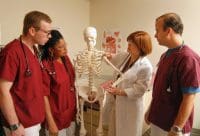When you compete for a seat in an advanced-degree program, your application can spell the difference between acceptance and rejection. Careful preparation, attention to detail, and the ability to follow directions are paramount.
Applying to an academic program entails obtaining information about the program, thoroughly and promptly filling out the application and other documents, taking entrance tests if required, obtaining letters of recommendation, arranging to have your prior academic transcripts forwarded, and being interviewed. (See The all-important interview by clicking the PDF icon above.)
Research the program
First, obtain information about the program you’re interested in from print or online sources. To determine if it offers the coursework and support you need to achieve your career goals, review the school’s mission statement, program outcomes, accreditation status, types of academic tracks available, faculty research interests, and admission requirements.
Complete the application
Find out about the requirements and deadline for submitting your application. Many academic institutions have both an online application and a paper application. Whichever one you choose, make sure to provide all the information requested. If you’re uncertain about a particular question, contact the institution for clarification before answering that question.
Submit your application and other requested documents promptly. If you omit a document, your application may be placed on hold or denied. If an application fee is required, include this in your admission packet.
Cover letter
Enclose a cover letter in your admission packet. In the letter, identify which academic program you’re applying to. Explain why you believe this program will help you meet your professional goals, how you plan to use the nursing degree you’ll obtain from the program, and how the institution’s mission meshes with your mission and values. Include a list of all items you’ve enclosed in the packet.
Personal statement
Many institutions require a personal statement in essay form in which you delineate your goals for the program you’re applying to, or describe your professional goals. Your statement will be scrutinized not only for content but for grammar, spelling, capitalization, and punctuation. Avoid slang. If a length limit is specified, don’t exceed it; otherwise, aim for two double-spaced pages.
Have several individuals read your statement, and ask them for suggestions on how you could improve it. Incorporate their suggestions into your final document.
Other admission requirements
Some academic programs may have additional admission requirements—for instance, a background check,
a drug screen, health information, and license verification. Review the admission requirements carefully and submit everything requested. (You might need to pay an additional fee for some of these.)
Take required entrance tests
Find out if you must take entrance tests; if so, the scores must be submitted with your application. Many nursing academic programs require the Graduate Record Examination (GRE) or Miller Analogies Test (MAT). Both exams have websites (www.ets.org/gre/ for the GRE and http://psychcorp.pearsonassessments.com/haiweb/Cultures/en-US/site/Community/PostSecondary/Products/MAT/mathome.htm for the MAT). The websites explain how to register for the test and list test fees, test centers, sample questions, and general test information. The academic program may specify the minimum test score you must achieve to be accepted, as well as a deadline for submitting your score. Send the test fee directly to the testing company; fees range from $70 to $190.
To prepare for the GRE, MAT, and other entrance tests, consider reading one of the many test-preparation books available from bookstores and online booksellers. Typically, these books include sample test questions and study materials. Review courses also are available; to find one, search online for the one nearest you.
Entrance tests may be given by computer at a testing center, with your test date and time scheduled through the center. Or a paper-and pencil test may be given at several designated times throughout the year, usually at a specific location.
Make a note of your test time and which identification (ID) forms are accepted. Find out what personal items you’ll be allowed to take into the testing area. Before leaving for the test center, be sure you have your ID with you.
Before you start the test, you’ll be asked to provide your demographic data and names of the institutions where the scores should be sent. Request that your scores be sent directly from the testing agency to the school to which you’re applying. Many schools don’t accept copies of test scores.
Arrange for letters of recommendation
Most academic institutions require applicants to provide letters of support and recommendation. Know how many letters are required. Letters should come from such individuals as previous nursing-school faculty members, peers, or work managers. If the school has a standardized form for the recommendation letter, provide this to your letter writers, along with the letter’s due date.
Find out whether the letters should be returned to you or sent directly to the institution. Either way, provide an addressed envelope. A short time after the due date, check with the school to make sure it has received the letters.
Have transcripts forwarded
You’ll need to have official transcripts sent from the registrar’s office of your previous academic institutions to the school to which you’re applying. The transcript identifies the courses you took, your grades, overall grade point average (GPA), and graduation date. Be aware that most schools require applicants to have earned a certain minimum GPA; if your GPA doesn’t meet this minimum, you may want to address this in your cover letter.
To initiate the transcript-forwarding process, submit a request to your previous institutions. You can do this either online or by calling the registrar’s office. You may have to pay a fee to have transcripts sent. Also, know that it may take more than 2 or 3 weeks for transcripts to be received; verify that the school has received them.
Check off application requirements
If the institution hasn’t provided an admissions checklist, create one yourself by listing all admission requirements, then check off each item as you provide it. Identify the admissions counselor at the institution and verify that the school has received all your test scores and other items requested. In your initial application packet, include most of the required elements; the fewer pieces of information that flow in separately, the less likely they are to get lost or misfiled.
Submitting your admission requirements within the deadline, verifying that your application is complete, and adequately preparing for your admission interview will improve your chance of getting into the school of your choice.
Selected references
Ellis SO. Nurse entrance test scores: a predictor of success. Nurse Educ. 2006 Nov-Dec;31(6):259-63.
Giddens J. The admissions committee: experiential learning in an online graduate nursing education course. J Nurs Educ. 2010 Mar;49(3):175-6. doi:10.3928/01484834-20100218-05.
Kramer LW. A personal reflection: graduate study challenges and strategies for success. Dimens Crit Care Nurs. 2007 Jul-Aug;26(4): 158-9.
Morgenthaler M. Too old for school? Barriers nurses can overcome when returning to school. AORN J. 2009 Feb;89(2):335-7, 341-5.
Janet Bischof is an assistant professor at Wheeling Jesuit University in Wheeling, West Virginia.


















